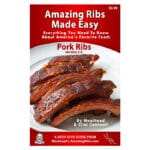Ribs are right there in our name: AmazingRibs.com. We’re crazy for incredible BBQ ribs and have plenty of smoked ribs recipes, cooking techniques, equipment recommendations, and mythbusting secrets throughout the site.
But we know sometimes you just want to see the highlight reel instead of watching the whole game. Sometimes you just want the key points. No problem. Yes, you can find a slew of mouthwatering rib recipes here on the site, including our famous Last Meal Ribs recipe. And you can find out all about National BBQ Ribs Day (July 4th) here. But if you want to reach total rib nirvana, here are the key steps you need to take.
- Select the Right Ribs for You
Among pork ribs, you’ll come across three distinct cuts — baby backs, spareribs, and St. Louis style or center cut. Baby backs are directly attached to the backbone of the pig, and they are the most tender and leanest ribs with most of the meat on top of the bones. Spareribs extend out from the baby backs and run all the way down to the chest of the pig. St. Louis Cut ribs are spareribs with the tips removed to create a nice rectangular rack. Spareribs and St. Louis ribs are the meatiest and most flavorful, and most of their meat is located between the bones. What about country-style ribs? They are misnamed. These are really pork chops and should be cooked differently than real ribs. For more info, check out our guide to pork cuts here.
Among beef ribs, you can opt either for the ultra-meaty plate ribs (i.e. ribs taken from the short plate next to the flank steak, often referred to as dinosaur ribs due to their mass) or the more flavorful, less meaty, back ribs (the ribs found in a prime rib roast). Learn more about various beef cuts here.
- Remove the Membrane
If the butcher has not already removed the paper-thin sheer membrane from the underside of your rack of ribs, do it yourself. When cooked, the membrane gets leathery and hard to chew, it keeps fat in, and it keeps sauce out. To remove it, insert a butter knife under the membrane to lift it up, then insert your fingers, work a section loose, grip it with a paper towel, and peel it off like a sticker. Finally, trim the excess fat from both sides of the rack. Need more details on removing the membrane. Get them here.
- Slather Up
Some cooks like to use mustard under their dry rub to help hold the spices onto the ribs. Instead, AmazingRibs.com’s Clint Cantwell suggests using a thin layer of mayonnaise since “it is mostly fat and fat is flavor!” Amen.
- Season It
The seasonings, usually a spice rub, should fuse onto the meat’s surface and enhance the meat, but not overwhelm it. For pork ribs, use kosher salt before adding your spice rub. At AmazingRibs.com, we recommend pre-salting meats 1-2 hours in advance to allow the salt to be fully absorbed, a process known as dry brining (read more about dry brining here), which enhances the juiciness of meat. Note that if you do dry brine, you’ll want to avoid commercial spice rubs that contain salt. Instead, for a flavorful homemade salt-free rub like Meathead’s Memphis Dust. For beef ribs, a simple kosher salt and cracked black pepper blend is best.
Hungry for more ribs recipes, tips, and techniques? Click here to download our ebook “Amazing Ribs Made Easy” $3.99 on Amazon (free Kindle app runs on all computers and devices). Or, get this book and others FREE as a member of the AmazingRibs.com Pitmaster Club. Click here to join.
- Smoke It
Add about 4 ounces of dry wood to your cooker for at least the first hour of cooking. Do not soak the wood! This is a myth that is fully debunked by AmazingRibs.com here.Put the wood as close to the flame as possible. The goal is to produce just enough smoke to complement the ribs and rub while avoiding a harsh, overpowering smoke flavor.
- Aim Low
The ideal cooking temp is about 225°F, hot enough to brown the surface, develop a crusty bark, and melt fat and collagens without making the meat tough. If you are not using a smoker, set up a gas or charcoal grill for 2-zone cooking using our complete guide here and cook the ribs on the indirect heat side of the grill. How long do they cook? On most cookers, when the oven temp is 225°F at sea level, it takes about three to four hours to cook a slab of baby backs and about five to six hours to cook a slab of St. Louis cut ribs or spares. At higher cooking temperatures, decrease the cooking time.
- Wrap If You Must
This optional trick (a.k.a. The Texas Crutch which you can read more about here) involves wrapping the slab of ribs in foil with about an ounce of water for up to an hour during the cook to speed along the process and tenderize the meat a bit. Almost all barbecue ribs competition cooks use the Texas Crutch to get an edge. But the improvement is really slight and, at AmazingRibs.com, we never bother with it for backyard cooking. If you crutch too long, you can turn the meat to mush and time in foil can soften the bark and remove a lot of rub.
- Sauce At The End
The sauce, if you use it at all, must remain subtle so as to not overwhelm the other flavors. Rib sauce is usually rich and slightly sweet to counterbalance the saltiness of the rub with a zippy pepperiness and acidic bite to counterbalance the sweetness. When adding sauce to ribs, be sure to do so only in the last few minutes of cooking, allowing just enough time for the sauce to become tacky but not long enough for the sugars in it to start to burn. One or two coats is enough. Don’t hide the flavors of the pork, rub, and smoke. Alternatively, you can skip the sauce altogether and serve them “dry,” or Memphis-style, allowing the meat, smoke, and rub to be the stars of the show. Learn more about the strategies for using sauce here.
eBooks By Our Staff

Amazing Ribs Made Easy
Everything You Need To Know About America’s Favorite Food: Pork Ribs, With Great Tested Recipes
by Meathead and Clint Cantwell We explain the different cuts, different cooking concepts and techniques and science to make the perfect pork ribs. Buy this $3.99 ebook here: Amazon Kindle, Google Play Books, Apple Books Or, get all our ebooks free when you join our Pitmaster Club- THIS IS NOT A PAID AD -



High quality websites are expensive to run. If you help us, we’ll pay you back bigtime with an ad-free experience and a lot of freebies!
Millions come to AmazingRibs.com every month for high quality tested recipes, tips on technique, science, mythbusting, product reviews, and inspiration. But it is expensive to run a website with more than 2,000 pages and we don’t have a big corporate partner to subsidize us.
Our most important source of sustenance is people who join our Pitmaster Club. But please don’t think of it as a donation. Members get MANY great benefits. We block all third-party ads, we give members free ebooks, magazines, interviews, webinars, more recipes, a monthly sweepstakes with prizes worth up to $2,000, discounts on products, and best of all a community of like-minded cooks free of flame wars. Click below to see all the benefits, take a free 30 day trial, and help keep this site alive.
Post comments and questions below
1) Please try the search box at the top of every page before you ask for help.
2) Try to post your question to the appropriate page.
3) Tell us everything we need to know to help such as the type of cooker and thermometer. Dial thermometers are often off by as much as 50°F so if you are not using a good digital thermometer we probably can’t help you with time and temp questions. Please read this article about thermometers.
4) If you are a member of the Pitmaster Club, your comments login is probably different.
5) Posts with links in them may not appear immediately.
Moderators